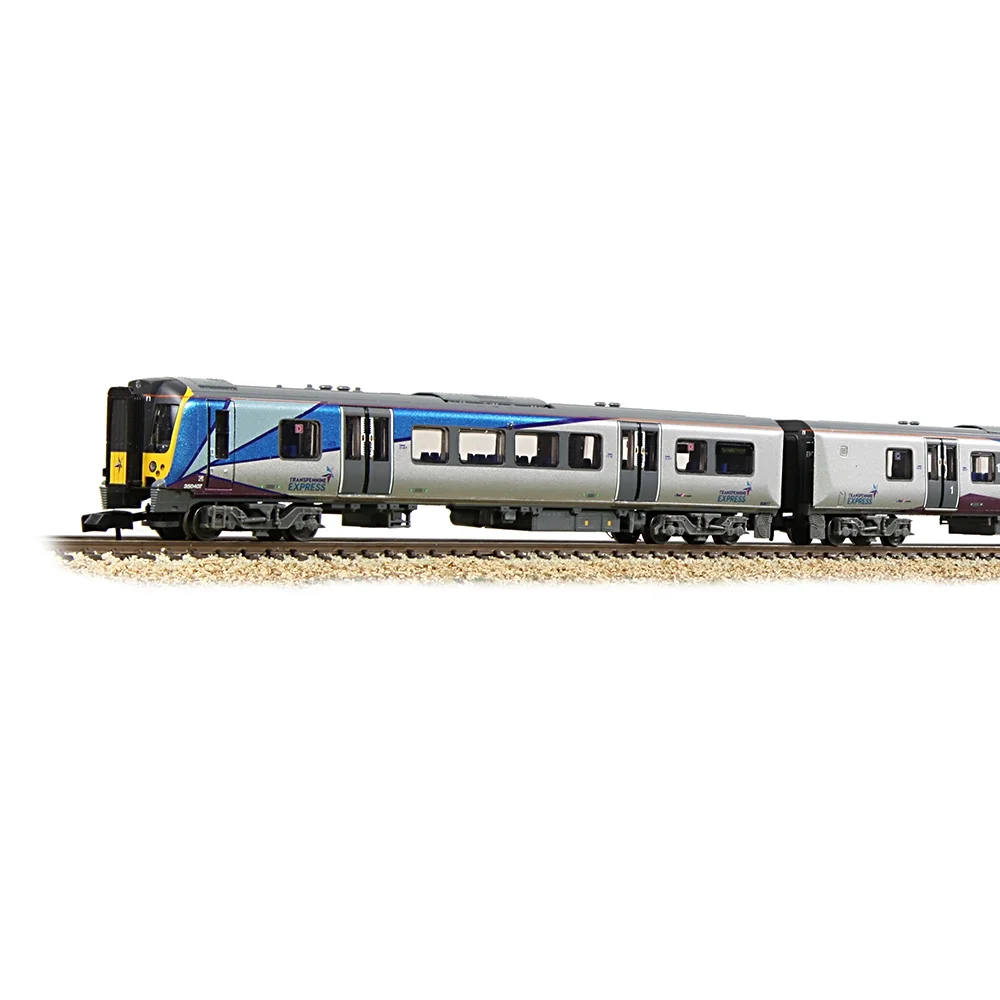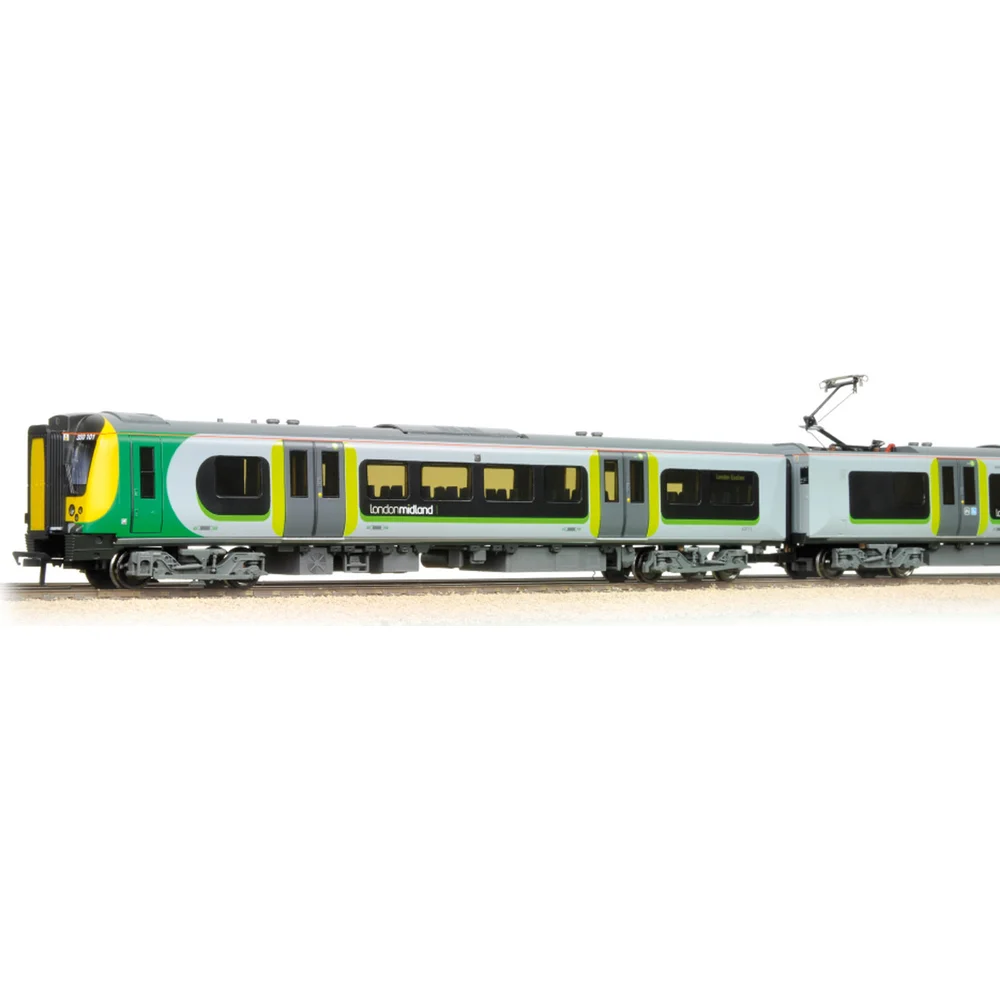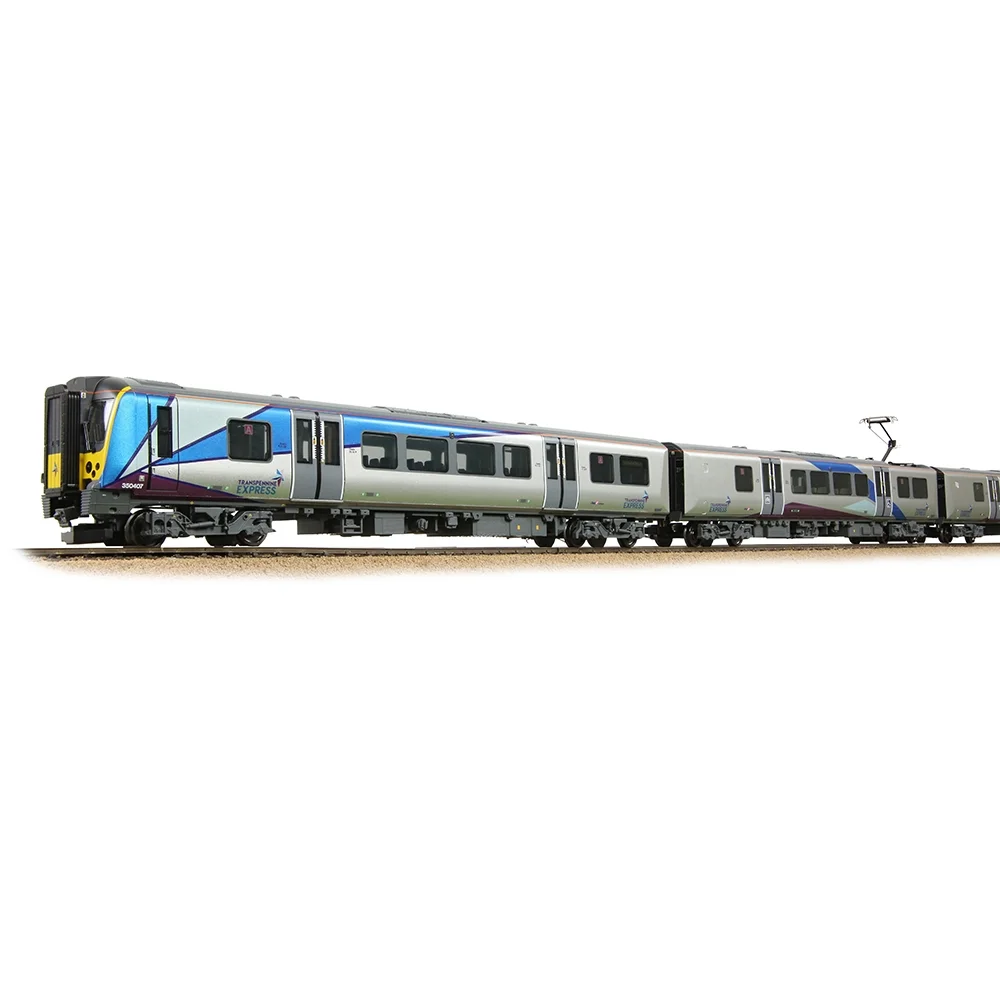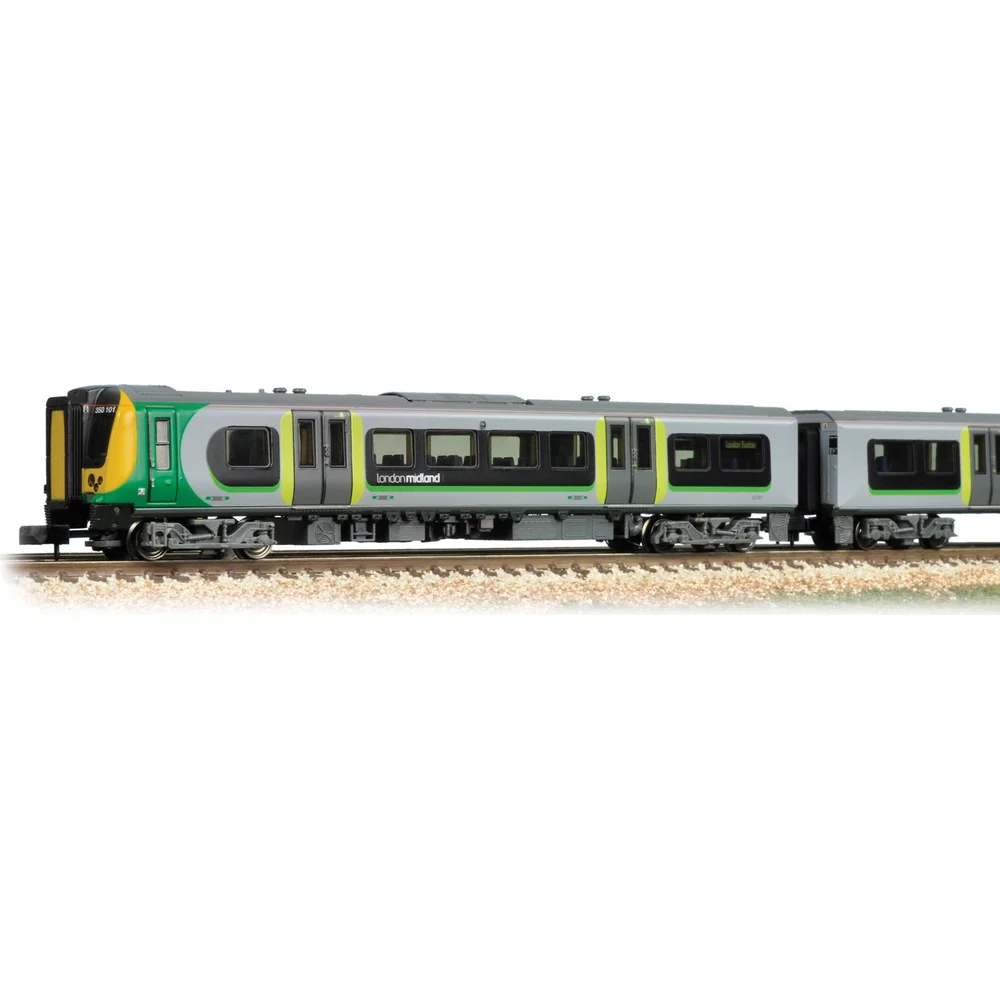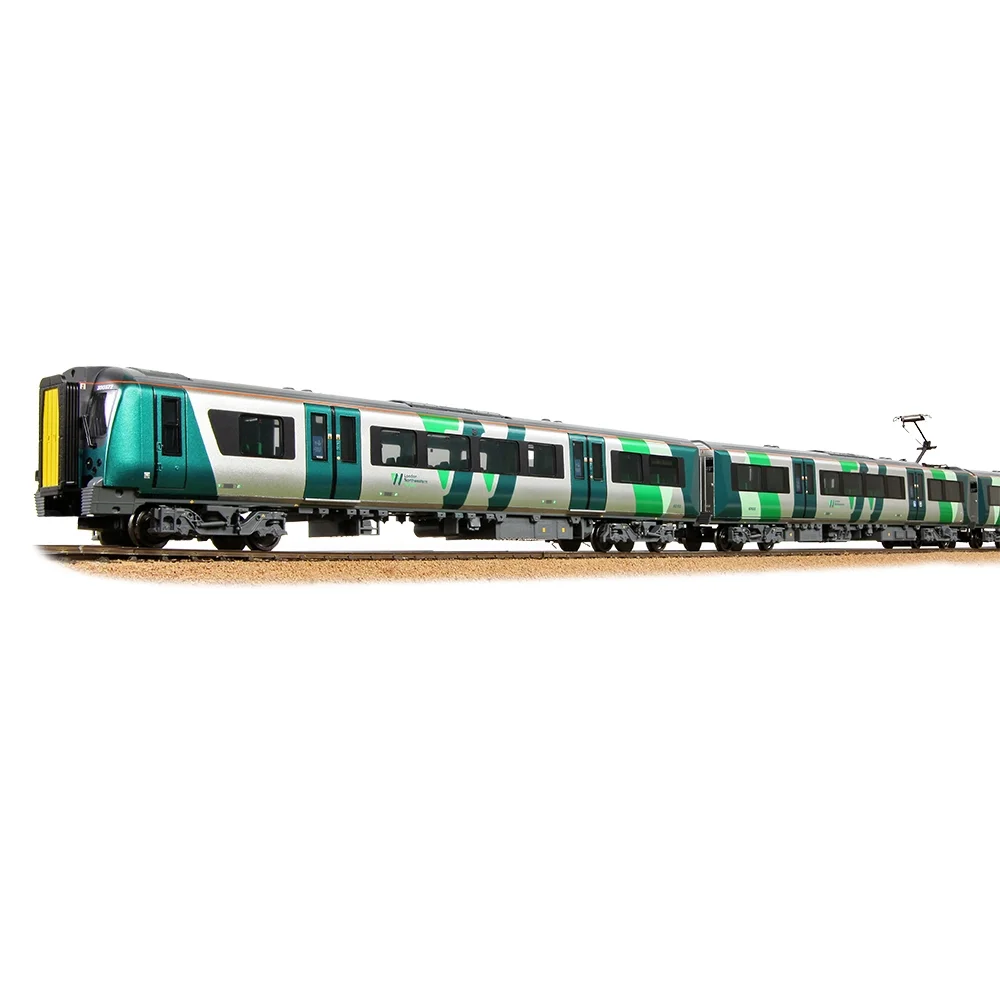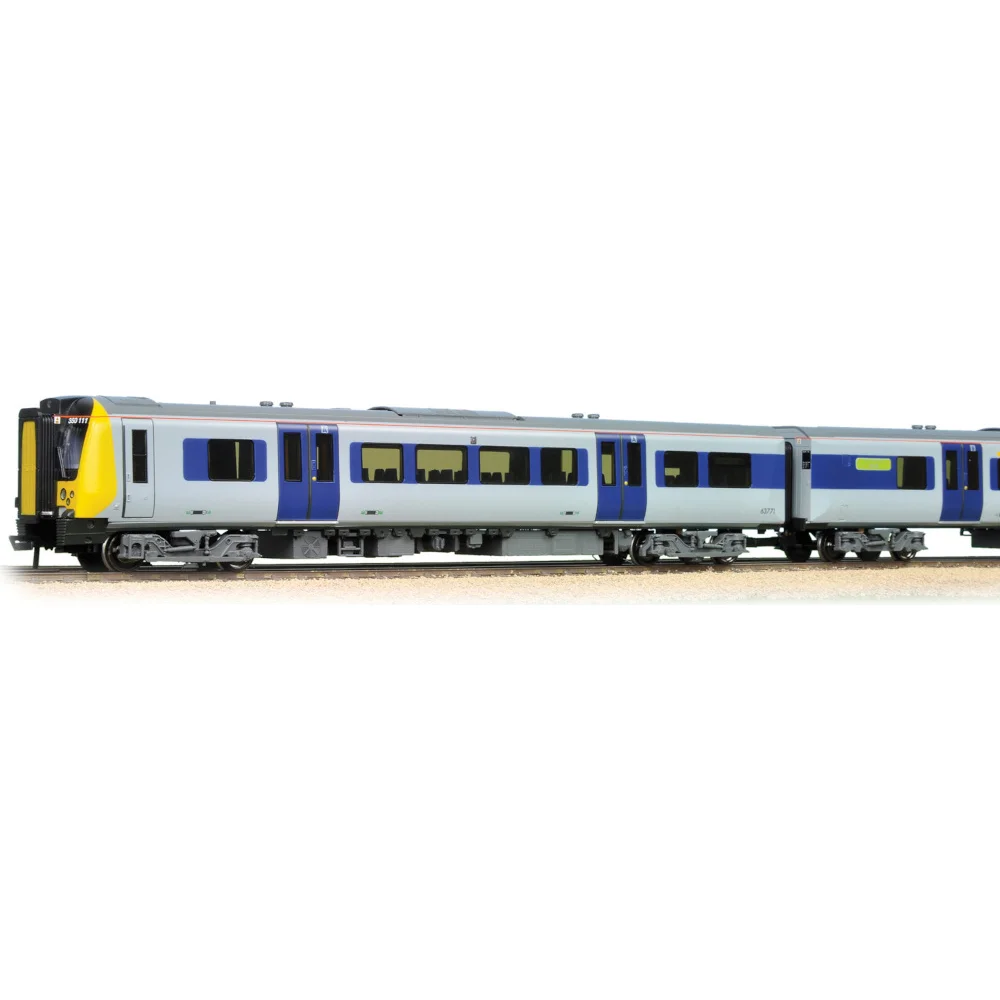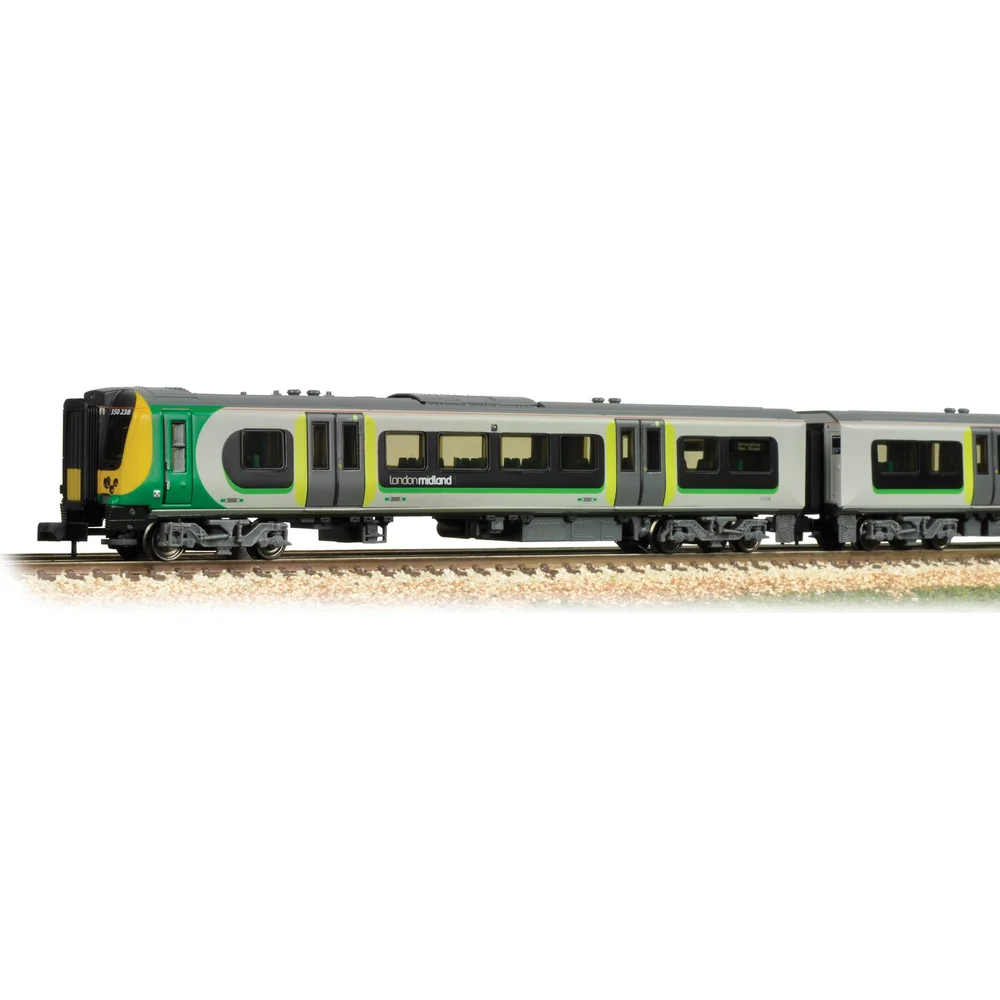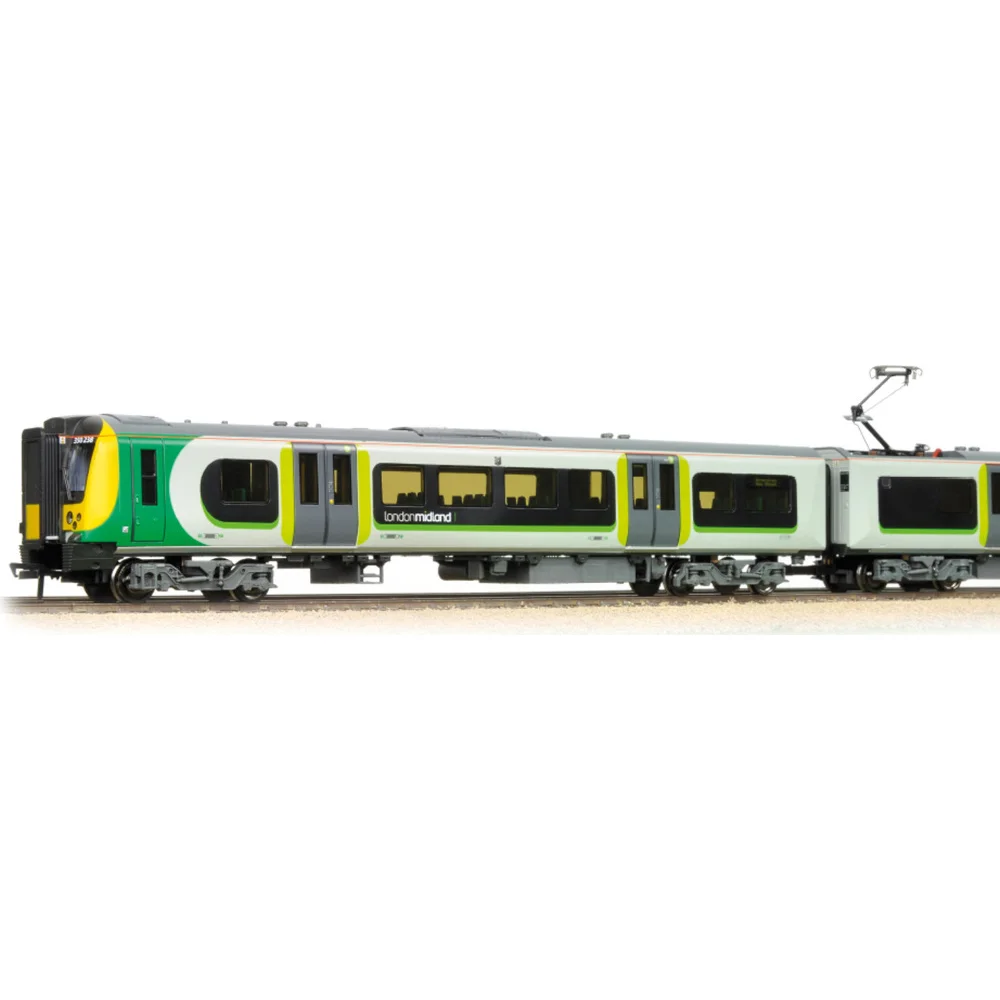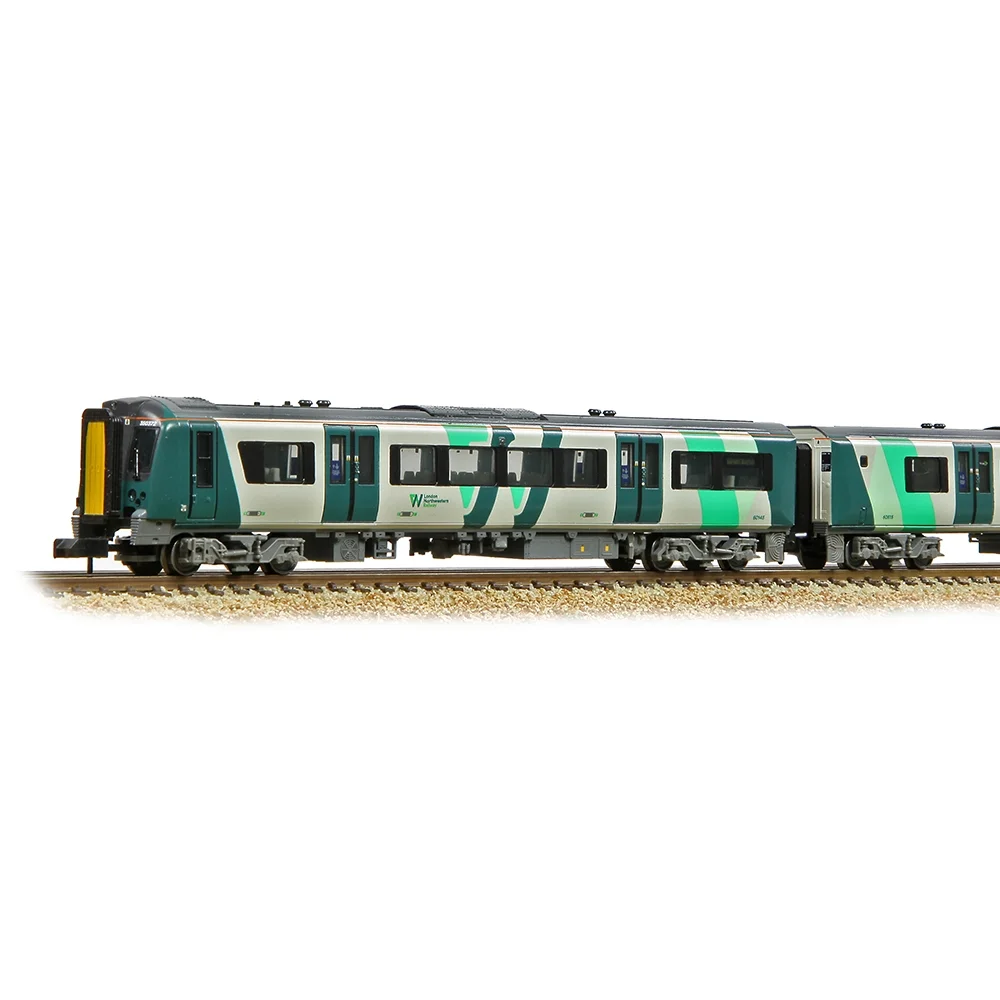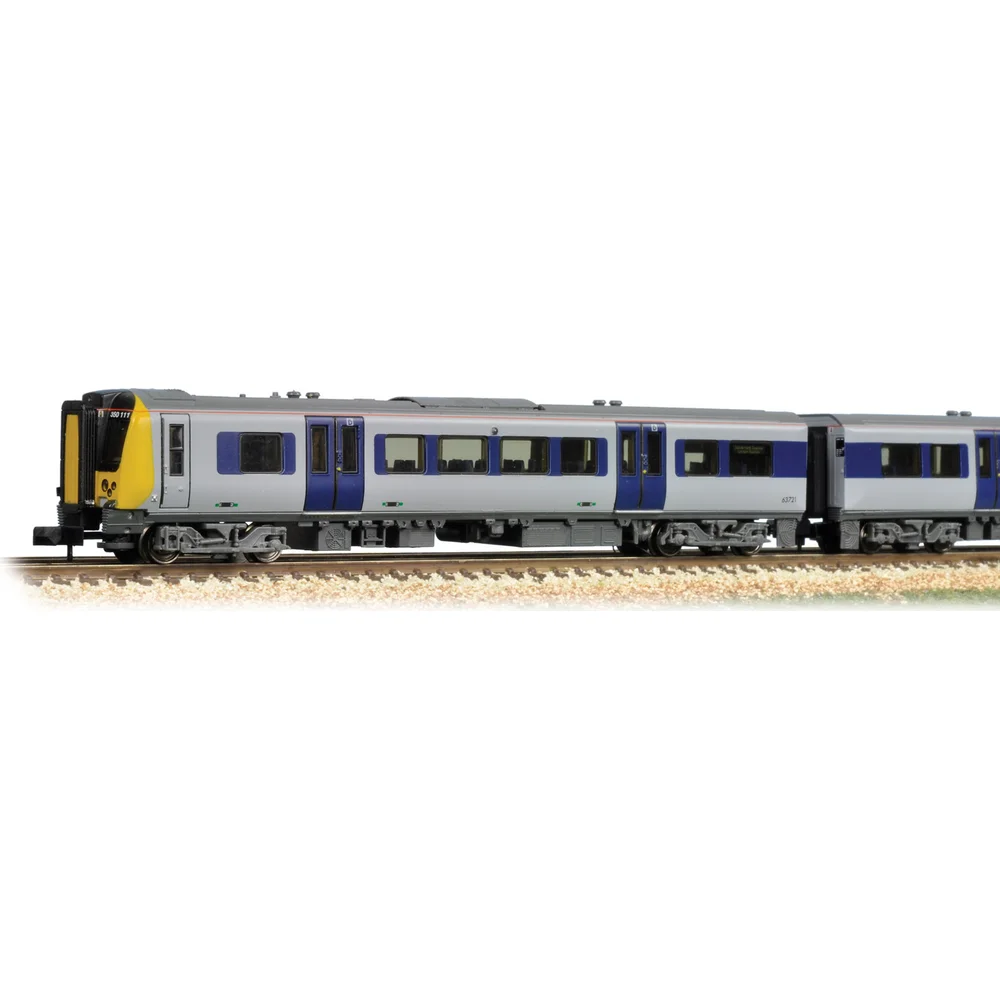British Rail Class 350 – Siemens Desiro Excellence for West Coast Main Line Services
Contents
The British Rail Class 350 Desiro represents one of the most successful electric multiple unit procurements in modern UK railway history, with all 87 units still operational after two decades. These Siemens-built trains transformed West Coast Main Line services from 2005 onwards, replacing aging slam-door stock with modern air-conditioned units featuring 110mph capability and industry-leading reliability records. For model railway enthusiasts, the Class 350 offers exceptional versatility with detailed OO and N gauge models from Bachmann and Graham Farish, authentic operational scenarios spanning 2005 to present, and diverse livery options from London Midland's green scheme to TransPennine Express's striking metallic finish.
The Desiro platform delivered precisely what Britain's railways needed in the early 2000s: modern, comfortable, reliable electric traction replacing Victorian-era infrastructure and operational patterns. Siemens' proven European design adapted brilliantly to UK requirements, creating a family of related units including Classes 360, 380, 444, and 450 that transformed passenger expectations across electrified routes. The Class 350's 20-year service history encompasses multiple operators, franchise transitions, comprehensive refurbishments, and the recent commencement of selective withdrawals as newer Class 730 Aventra units arrive.
From their surprising origins as diverted South West Trains stock to becoming London Northwestern Railway's backbone, the Class 350 fleet demonstrates how thoughtful procurement and sustained maintenance investment deliver exceptional value. The trains' modular construction enabled progressive upgrades from 100mph to 110mph maximum speed, interior refurbishments incorporating USB charging and LED lighting, and technical modifications including GSM-R radio retrofits—all while maintaining industry-leading reliability statistics exceeding 100,000 miles between technical incidents.
Quick Takeaways
- Eighty-seven units built: Constructed at Siemens facilities in Vienna, Austria and Uerdingen, Germany across four batches between 2004-2014 comprising 350/1 (30 units), 350/2 (37 units), 350/3 (10 units), and 350/4 (10 units)
- Desiro UK platform excellence: Proven European design adapted to stringent UK requirements including heavier construction, enhanced crashworthiness, and specific loading gauge constraints whilst maintaining modularity across related classes
- Two-decade operational success: From June 2005 entry into service through October 2025, demonstrating remarkable reliability with Porterbrook citing 100,420 miles per technical incident for Class 350/2 fleet in 2018
- Progressive technical upgrades: Systematic improvements including 100mph to 110mph speed upgrades completed 2012-2018, comprehensive interior refurbishments 2019-2024, and GSM-R radio retrofits ensuring contemporary standards
- Extensive route coverage: Primary WCML services London Euston to Birmingham, Liverpool, Crewe, and Northampton plus TransPennine Express Manchester-Scotland operations 2013-2020, Abbey Line operations from 2021, and diverse West Midlands regional services
- Comprehensive model availability: Bachmann OO gauge range includes four variants across London Midland, TransPennine Express, and London Northwestern Railway liveries with DCC-ready and sound-fitted options; Graham Farish N gauge provides parallel product line
- Selective withdrawal commencing: Class 350/2 sub-class began off-lease returns October 2024 as Class 730 Aventra replacements entered service, whilst Class 350/1, 350/3, and 350/4 variants continue with recent refurbishments indicating medium-term retention
Historical Background and Context
The Class 350 programme emerged from an unexpected procurement detour in 2001 when the Strategic Rail Authority reallocated rolling stock from South West Trains' existing Siemens order. Originally, SWT had ordered 785 vehicles including 32 five-car Class 450 units totaling 160 carriages. The SRA diverted 120 of these carriages, modified them for 25kV AC overhead operation, and created 30 four-car Class 350/1 units designated for Central Trains and Silverlink—both National Express Group subsidiaries requiring modern traction for West Midlands and WCML services.
Siemens' Desiro UK platform won selection through proven European reliability, modular adaptability demonstrated by the near-identical Class 450 units, and comprehensive modern features absent from 1980s British Rail stock. The platform offered rapid acceleration for frequent-stop services, full air conditioning, accessible toilets with waste retention systems, and flexible electrical configurations enabling both AC overhead and DC third rail capability on the initial 350/1 variant. This adaptability proved commercially valuable as the same basic design spawned Classes 360, 380, 444, and 450, creating maintenance economies across the Desiro UK family.
Manufacturing and testing unfolded across multiple European facilities from 2004 onwards. Siemens constructed units at Vienna, Austria and Uerdingen, Germany plants, with all vehicles requiring 1,000 trouble-free miles at Wildenrath Test Track in Germany plus 300 UK miles before acceptance. The first Class 350/1 units entered revenue service in June 2005 with Central Trains operating Birmingham-Northampton-Liverpool routes and Silverlink handling London Euston-Milton Keynes Central-Northampton services. These 30 units wore neutral grey and blue livery reflecting their shared-fleet status between both operators.
The programme's timing proved fortuitous, arriving as the UK rail industry desperately needed slam-door stock elimination. Contemporary context saw widespread franchise renewals, West Coast Main Line modernization nearing completion, and passenger expectations rising for continental-standard comfort. The Class 350 delivered precisely when operators required modern capacity, arriving alongside the railway industry's digital revolution of real-time passenger information, CCTV security, and GSM-R communications—all integrated from delivery.
Insider Tip: Dual-Voltage Capability Recognition
Class 350/1 units retain unique dual-voltage capability with both 25kV AC overhead pantographs and 750V DC third rail collection shoes, enabling operation on mixed electrification systems. You can identify these specialist units by examining the underframe for collector shoe equipment alongside roof-mounted pantographs. This feature, absent from later 350/2, 350/3, and 350/4 sub-classes, theoretically enables operation on both West Coast Main Line overhead routes and Southern Region third-rail infrastructure, though current diagrams rarely exploit this versatility.
When Central Trains and Silverlink franchises expired simultaneously on 11 November 2007, the entire Class 350/1 fleet transferred to new operator London Midland, managed by Govia. This marked the beginning of substantial fleet expansion with 37 Class 350/2 units ordered in late 2007 for £164 million to replace aging Class 321 EMUs. The first Class 350/2 was ceremonially handed over at Wildenrath on 8 October 2008, with all 37 units (350231-350267) delivered by 30 July 2009. Later orders brought 10 Class 350/3 units for London Midland (2013-2014) and 10 Class 350/4 units for First TransPennine Express (2013-2014), completing the 87-unit fleet still operational today.
Design and Technical Specifications
The Siemens Desiro UK platform represents a heavier, more robust interpretation of the lighter Desiro Classic design used across continental Europe. Siemens specifically engineered this variant to meet stringent UK loading gauge requirements, structural strength standards, and crashworthiness regulations exceeding European norms. All Class 350 units measure 20.34m per vehicle with 2.80m width, creating an approximately 81.36m total length for the standard four-car formation—no three-car or five-car variants exist in the Class 350 fleet.
Power delivery utilizes eight Siemens 1TB2016-0GB02 asynchronous three-phase AC induction motors, each producing 250kW (335hp) for a combined 2,000kW (2,680hp) output per unit. These motors mount directly on axles with two motors per bogie on both driving cars' inner bogies, providing all-axle traction across the motor vehicles. The electrical system draws from 25kV 50Hz AC overhead lines via roof-mounted pantographs on the third vehicle (designated PTSO or PTOSLW depending on sub-class). Uniquely, the Class 350/1 sub-class features dual-voltage capability with additional 750V DC third rail shoes, enabling operation on both overhead and third-rail electrified routes—a capability removed from later sub-classes but theoretically retrofittable if required.
Performance specifications evolved throughout the fleet's life. Initial units achieved 100mph (160km/h) maximum speed, but London Midland upgraded Class 350/1 units to 110mph (180km/h) in December 2012 under "Project 110," enabling mixed running with faster services and improving WCML path utilization during Euston station capacity works. The Class 350/2 fleet received similar upgrades throughout 2018, while Class 350/3 and 350/4 units delivered with 110mph capability from manufacture. This performance, combined with regenerative braking returning energy to the overhead supply, delivers excellent operational economics with rapid acceleration between frequent stops characteristic of semi-fast services.
Braking systems incorporate multiple technologies including regenerative electric braking as the primary method (returning energy to overhead supply), electro-pneumatic control for precise response, and disc brakes on all axles providing mechanical backup. Safety systems progressed through the production batches, with Class 350/3 and 350/4 units featuring TPWS Mark 2 with three warning lights and vocal alarms, plus GSM-R (Global System for Mobile Communications - Railway) from delivery. Earlier units received GSM-R retrofits alongside retention of traditional CSR (Cab Secure Radio) and NRN (National Radio Network) systems, creating a triple-redundancy communications architecture exceeding previous UK EMU standards.
Technical Innovation: Interior Configuration Variations
Class 350 sub-classes demonstrate how identical external platforms accommodate dramatically different interior specifications. Class 350/1 and 350/3 units feature comfortable 2+2 seating (two seats each side of the aisle) throughout standard class, providing 206 seats optimized for longer-distance regional services. Conversely, Class 350/2 units employ high-density 3+2 seating (three seats one side, two opposite) maximizing capacity to 246 standard class seats for intensive commuter operations. This flexibility enabled operators to specify passenger capacity versus comfort trade-offs whilst maintaining fleet standardization for maintenance economies.
Passenger capacity varies significantly between sub-classes based on intended service patterns. Class 350/1 units feature 2+2 seating throughout providing 206 standard class seats plus 24 first class seats, optimized for longer-distance regional services where comfort matters. Conversely, Class 350/2 units employ 3+2 seating in standard class maximizing capacity to 246 standard class seats plus 24 first class for high-density commuter services. Standing capacity adds 117-149 passengers depending on configuration, yielding approximately 350-395 total capacity per unit—explaining the class number's appropriateness. All units include dedicated wheelchair spaces in the pantograph trailer vehicle, accessible toilets meeting modern PRM (Persons of Reduced Mobility) standards, priority seating areas, and full climate control throughout.
| Specification | Value |
|---|---|
| Classification | British Rail Class 350 Desiro |
| Manufacturer | Siemens Transportation Systems (now Siemens Mobility) |
| Build Location | Vienna, Austria & Uerdingen, Germany |
| Build Years | 2004-2014 (350/1: 2004-05; 350/2: 2008-09; 350/3 & 350/4: 2013-14) |
| Total Fleet | 87 units (30×350/1, 37×350/2, 10×350/3, 10×350/4) |
| Formation | 4-car EMU only (DMCO/DMOS-TCO/TOCL-PTSO/PTOSLW-DMCO/DMOS) |
| Unit Length | ~81.36m (4 cars × 20.34m each) |
| Vehicle Width | 2.80m |
| Power Supply | 25kV 50Hz AC overhead (all); 750V DC third rail (350/1 only) |
| Traction Motors | 8× Siemens 1TB2016-0GB02 asynchronous AC (250kW each) |
| Total Power Output | 2,000kW (2,680hp) per 4-car unit |
| Maximum Speed | 110mph (180km/h) - upgraded from original 100mph |
| Braking | Regenerative + electro-pneumatic disc brakes on all axles |
| Seating Capacity | First: 24 seats; Standard: 206-246 (2+2 or 3+2 configuration) |
| Total Capacity | ~350-395 passengers (seated + standing) |
| Features | Full air conditioning, CCTV, LCD/dot-matrix displays, USB charging, wheelchair spaces, GSM-R/CSR/NRN radio |
| Safety Systems | TPWS (Mark 2 on newer units), AWS, fire detection, DSD |
| Depot | Kings Heath, Northampton (Siemens-managed, opened June 2006) |
| Owners | Angel Trains (350/1, 350/3, 350/4); Porterbrook (350/2) |
| Current Operator | West Midlands Trains (London Northwestern Railway/West Midlands Railway brands) |
Service History and Operations
London Midland's November 2007 franchise commencement marked the Class 350's golden era, with the fleet expanding from 30 to 67 units by mid-2009. The operator deployed Class 350/1 units on Birmingham-Northampton via Coventry services, Birmingham-Liverpool routes, and continuing the inherited Euston-Milton Keynes Central-Northampton diagrams. The 37 Class 350/2 arrivals enabled comprehensive Class 321 replacement, with the entire older fleet cascaded to other operators by early 2010. London Midland introduced new Crewe-London Euston services via Stoke-on-Trent and Trent Valley Line stations (Stafford, Rugeley Trent Valley, Lichfield Trent Valley), leveraging the Class 350's 100mph capability to provide competitive journey times against Virgin Trains' Pendolinos on parallel fast lines.
Fleet sub-classes reflect distinct operational requirements and procurement circumstances. Class 350/1 units (350101-350130, owned by Angel Trains) retain dual-voltage capability enabling third-rail operation, though this feature sees minimal use in current diagrams. Class 350/2 units (350231-350267, owned by Porterbrook) adopted AC-only configuration with higher-density 3+2 seating for intensive commuter services, achieving remarkable reliability with Porterbrook citing 100,420 miles per technical incident in 2018—among the best performance in UK railway history. Class 350/3 units (350368-350377, Angel Trains) delivered to near-identical 350/2 specification but with 2+2 seating and 110mph capability from manufacture, entering London Midland service in October 2014. Class 350/4 units (350401-350410, Angel Trains) represented the most significant operational departure, built specifically for First TransPennine Express with distinctive features including three toilets versus two, dedicated cycle storage areas, catering trolley accommodation, and initially unique 2+1 first class seating.
TransPennine Express deployed its ten Class 350/4 units from 30 December 2013 on newly electrified Manchester-Scotland routes, with trains operating Manchester Piccadilly/Airport to Glasgow Central and Edinburgh Waverley services. These units replaced Class 185 diesel units on three daily return workings, each unit averaging 260,000 miles annually on the 214-mile route with eight intermediate stops. The TPE operation lasted until 2019-2020 when Class 397 Civity units arrived, prompting transfer of all ten 350/4 units to West Midlands Trains where they received interior reconfiguration including first class seat replacement for fleet standardization.
Operational Insight: Project 110 Speed Upgrades
London Midland's "Project 110" transformation deserves special recognition as one of the most successful EMU upgrade programmes in UK railway history. Completed December 2012 for Class 350/1 units and throughout 2018 for Class 350/2 units, these modifications increased maximum speed from 100mph to 110mph through software updates, traction motor modifications, and bogie suspension adjustments. The upgrades enabled mixed running with faster Virgin Trains services on WCML fast lines, improved path utilization during Euston capacity constraints, and enhanced journey time competitiveness—all achieved without major structural modifications or excessive downtime.
Major incidents punctuated otherwise exemplary service records. In 2005, units 350105 and 350108 sustained damage colliding with a fallen tree, requiring return to Germany for repairs. On 11 April 2011, unit 350232 suffered a fire incident near Leighton Buzzard resulting in one fatality (subsequently determined as suicide); the unit was repaired at Wolverton Works and later named "Chad Varah" honoring the Samaritans founder, carrying suicide prevention messaging. The most serious incident occurred on 16 September 2016 when unit 350264 struck a landslide at Watford Tunnel entrance and derailed, subsequently hit by unit 350233 traveling in the opposite direction. Both units sustained severe leading-car damage, were transported to Germany by low-loader in November 2016, and re-entered service in early 2018 after extensive repairs demonstrating the fleet's robust crashworthiness design.
West Midlands Trains inherited 77 Class 350 units when the franchise commenced on 9 December 2017, operating under London Northwestern Railway and West Midlands Railway brands. The fleet absorbed the ten TransPennine 350/4 units in 2019-2020, reaching the full 87-unit complement. WMT introduced Class 350 operation on the Abbey Line (Watford Junction-St Albans Abbey) from May 2021, replacing Class 319 units and demonstrating the fleet's versatility across diverse route types. Refurbishment programmes focused on Class 350/1 units (2019-2021) and Class 350/3 units (2023-2024, mini-refurbishment), while Class 350/2 units deliberately received minimal investment anticipating their replacement.
Throughout their service life, Class 350 units have earned multiple industry awards including Golden Spanner awards for maintenance excellence and consistent recognition for operational reliability. The fleet's success stems from Siemens' robust design, effective maintenance at Kings Heath depot (purpose-built in June 2006 with capacity for eight simultaneous units), and continuous improvement programmes including speed upgrades, interior refreshes, and technology retrofits keeping 20-year-old units competitive with newer rolling stock.
Fleet
No locomotives found.
Withdrawal and Preservation Legacy
As of October 2025, the Class 350 fleet stands at a pivotal transition point with withdrawals commencing after two decades of intensive service. The Class 350/2 sub-class became the first variant to face retirement when Porterbrook began sending units off-lease in October 2024, replaced by 36 five-car Class 730/2 Aventra units that entered service from 9 June 2025. Initial withdrawals included 350244, 350251, and 350255 in October 2024, followed by additional units including 350238 in November. Stored at Wolverton Works and Long Marston, these units await uncertain futures as potential candidates for cascading, battery-electric conversion, or scrapping.
Porterbrook's 2018 "BatteryFLEX" proposal represents the most intriguing retirement alternative, suggesting conversion of withdrawn Class 350/2 units to battery-electric multiple units for non-electrified routes. Engineering assessments identified the Oxenholme-Windermere branch and various Northern England routes as suitable candidates where overhead electrification proves economically unviable but modern traction is desired. August 2025 trials on the Glossop Line tested this concept, with unit 350244 moved to Northwest England for evaluation. Success could extend the 350/2 fleet's operational life by another decade while enabling zero-emission operation on diesel-dependent routes, though battery technology challenges and infrastructure investment requirements remain substantial.
Speculation about cascading to other operators gained momentum throughout 2024-2025, with Northern Trains frequently mentioned as a potential recipient to replace their aging Class 323 units (34 units dating from 1992-1993). Open access operator proposals for Stirling-Euston services using Class 350 units have also circulated, though no formal announcements emerged. The units' standardized Desiro platform, proven reliability, and remaining service life make them attractive for operators seeking proven capacity without new-build costs, but lease negotiations and compatibility with destination operators' infrastructure complicate any transfers.
Preservation's Future Opportunity
Unlike many withdrawn EMU classes that disappeared entirely into scrapyards, the Class 350 fleet exists in an era when railway preservation actively seeks modern traction examples. The National Railway Museum maintains interest in preserving Desiro UK family representatives given their transformative impact on 21st-century British railways. Likely preservation candidates include unit 350101 (first of class), unit 350232 ("Chad Varah" with historical significance), unit 350407 (TransPennine Express variant), and representatives from each sub-class. However, preservation societies face challenges storing and maintaining large four-car EMU formations requiring specialist electrical knowledge and 25kV overhead infrastructure.
The remaining 50 Class 350/1, 350/3, and 350/4 units (all Angel Trains-owned) face no immediate retirement threats. Recent refurbishments—particularly the 2019-2021 Class 350/1 programme and 2023-2024 Class 350/3 mini-refurbishment—indicate operator commitment to medium-term retention. These units provide critical capacity on West Coast Main Line services where passenger numbers recovered post-pandemic, Birmingham-Liverpool routes requiring the units' specific performance characteristics, and various West Midlands regional services. Capacity constraints at London Euston, platform length restrictions at certain stations favoring 350s over longer Class 730 formations, and the units' 110mph capability maintaining schedule integrity all support continued operation.
Expected remaining service life projections suggest Class 350/1 units might operate until 2030-2035 (26-31 years from 2004-2005 construction), while Class 350/3 and 350/4 units could serve until 2035-2040 given their 2013-2014 construction dates and recent refurbishments. Industry precedent shows well-maintained UK EMUs routinely achieving 30-35 year service lives—Class 321 units (1988-1991) operated until 2020-2023, demonstrating the viability of extended EMU service with appropriate maintenance investment. The February 2026 franchise transition when West Midlands Trains services revert to public ownership under direct DfT control may influence retention decisions, though immediate replacement appears unlikely given Class 730 production commitments and absence of alternative modern EMU capacity.
Modelling Significance and Scale Replications
The BR Class 350 Desiro enjoys strong representation in model form, though manufacturers are fewer than enthusiasts might expect. Only two companies produce Class 350 models: Bachmann in OO gauge (1:76 scale, 4mm:1ft) and Graham Farish in N gauge (1:148 scale, 2mm:1ft). Contrary to common assumptions, Hornby, Dapol, Heljan, and Revolution Trains have never manufactured Class 350 models, making Bachmann and Graham Farish the exclusive sources for this modern EMU. This limited manufacturer base stems partly from the Class 350's relatively recent service entry (2005), the specialized EMU market segment, and Bachmann/Graham Farish's strategic focus on modern traction where competitors concentrate on heritage and diesel subjects.
Bachmann introduced the Class 350 to its Branchline range in 2011 with two London Midland-liveried variants: item 31-031 (Class 350/2, unit 350238) and item 31-032 (Class 350/1, unit 350101). These initial releases established high quality standards with extensively detailed four-car formations featuring poseable sprung metal pantographs, comprehensive underfloor equipment molding, separate windscreen wipers, illuminated destination panels, detailed cab interiors with seats and control desks, passenger saloons with tables and chairs, directional lighting switchable via DCC or chassis-mounted switches, interior lighting with integral capacitors preventing flicker, and 21-pin DCC decoder sockets with speaker enclosures ready for sound decoder installation. The models measure approximately 1,080mm over couplings, requiring substantial layout space but delivering impressive visual impact.
Spring 2025 brought exciting new Bachmann announcements with refreshed tooling and expanded livery coverage. Item 31-033 represents Class 350/4 unit 350407 in First TransPennine Express livery (sparkling silver with blue and purple stripes), correctly formed as DMOS 60697 + PTOSLW 60947 + TOCL 60907 + DMOS 60677 with "Manchester Airport" destination blinds. The standard DCC-ready version carries an RRP of £469.95, while item 31-033SF provides the same unit with factory-fitted ESU sound decoder for £569.95. Item 31-034 delivers Class 350/3 unit 350372 in current London Northwestern Railway livery (white with teal and green), formed as DMOS 60145 + TOCL 60515 + PTOSLW 60655 + DMOS 60155 with "London Euston" blinds, available as standard (31-034, £469.95) or sound-fitted (31-034SF, £569.95) versions. These 2025 releases incorporate refined detail including improved bogie molding, enhanced roof detail with cabling and insulators accurately represented, and updated passenger information displays.
Advanced Modelling: DCC Sound Installation Options
Bachmann OO gauge Class 350 models provide exceptional flexibility for DCC sound conversion. The 21-pin decoder socket accepts standard decoders including Bachmann's own 36-557A decoder or premium alternatives like ESU LokSound V5. Sound-fitted models include factory-installed ESU decoders with audio specifically recorded from real Class 350/450 units, capturing authentic traction motor whine, door chimes, passenger announcements, and warning horns. These sound-fitted versions operate on both DCC and analog DC control with prototypical start-up sequences. For modellers wanting ultimate customization, aftermarket sound projects enable programming custom announcements, station stops, and operational scenarios.
Graham Farish (Bachmann's N gauge brand) paralleled the OO gauge releases with its own Class 350 programme commencing in 2012. Initial offerings included item 371-701 (Class 350/2 unit 350238 London Midland) and item 371-702 (Class 350/1 unit 350101 London Midland), both featuring detailed underfloor equipment remarkable for N gauge scale, prototypical sprung pantographs, illuminated cab destination signs, bi-directional cab end lights, directional lighting switchable via DCC or chassis, NEM couplings, and 6-pin DCC decoder sockets. The N gauge models present DCC installation complexity compared to OO equivalents—each Graham Farish Class 350 requires three separate decoders (one per powered section) due to absence of inter-car electrical drawbars, whereas Bachmann OO models need only one decoder per four-car unit thanks to inter-car electrical couplings distributing power throughout.
Recent Graham Farish releases expanded livery coverage to match Bachmann's OO range. Item 371-703 delivers Class 350/4 unit 350407 First TransPennine Express (RRP £349.95, frequently discounted to £269.95—22% off at major retailers), while item 371-704 provides Class 350/3 unit 350372 London Northwestern Railway (RRP £349.95-£399.95). These N gauge models measure approximately 576mm over couplings, offering space-conscious modelers authentic Class 350 operation within more modest layout dimensions. Quality levels impress for N gauge scale, with separate underfloor parts, gangways, roof details, and accurate tooling variations between Class 350 and related Class 450 Desiro models (third-rail variants lacking pantographs).
Available liveries span the Class 350's operational history with notable gaps. Both manufacturers offer London Midland's green and grey scheme (2007-2017 era), First TransPennine Express's metallic silver/blue/purple (2013-2020), and London Northwestern Railway's white/teal/green (2017-present). Conspicuously absent are the original Central Trains/Silverlink neutral grey and blue livery (2005-2007), Central Trains standalone branding, West Midlands Railway orange and purple, and special liveries including the colorful Eurovision 2023 scheme applied to unit 350104 or various destination promotional wraps. Custom painting or commissioning professional livery services from specialists like Olivia's Trains or The Model Centre can fill these gaps for modelers seeking specific prototypes.
Retail availability and pricing fluctuate with release cycles. Major UK retailers including Rails of Sheffield, Hattons Model Railways, Kernow Model Rail Centre, The Model Centre, and Cheltenham Model Centre stock both Bachmann and Graham Farish ranges, typically offering 10-22% discounts off RRP. Pre-owned models occasionally surface at £169.50-£255 depending on condition, while weathered versions from The Model Centre command £206-£239. Bachmann's 2025 releases entered pre-order status in spring 2025 with expected delivery August-September 2025, though delivery dates remain provisional subject to production schedules.
Models
| Builder | Catalogue # | Year | Running # | Class, Operator (Livery) "Name" | Scale | Finish | Era | DCC |
|---|---|---|---|---|---|---|---|---|
| Bachmann | 31-030 | 2010 | 350111 | British Rail Class 350, Silverlink (Silver & Blue) "Apollo" | OO | P | 9 | DCC21 |
| Bachmann | 31-031 | 2010 | 350238 | British Rail Class 350, London Midland (Green & Grey) | OO | P | 9 | DCC21 |
| Bachmann | 31-032 | 2010 | 350101 | British Rail Class 350, London Midland (Green & Grey) | OO | P | 9 | DCC21 |
| Bachmann | 31-033 | 2025 | 350407 | British Rail Class 350, First TransPennine Express | OO | P | 9 | DCC21 |
| Bachmann | 31-033SF | 2025 | 350407 | British Rail Class 350, First TransPennine Express | OO | P | 9 | DCCS |
| Bachmann | 31-034 | 2025 | 350372 | British Rail Class 350, West Midlands Trains (London Northwestern Railway) | OO | P | 9 | DCC21 |
| Bachmann | 31-034SF | 2025 | 350372 | British Rail Class 350, West Midlands Trains (London Northwestern Railway) | OO | P | 9 | DCCS |
| Graham Farish | 371-700 | 2011 | 350111 | British Rail Class 350, Silverlink (Silver & Blue) "Apollo" | N | P | 9 | DCC6 |
| Graham Farish | 371-701 | 2011 | 350238 | British Rail Class 350, London Midland (Green & Grey) | N | P | 9 | DCC6 |
| Graham Farish | 371-702 | 2011 | 350101 | British Rail Class 350, London Midland (Green & Grey) | N | P | 9 | DCC6 |
| Graham Farish | 371-703 | 2018 | 350407 | British Rail Class 350, TransPennine Express (Silver) | N | P | 11 | DCC6 |
| Graham Farish | 371-704 | 2024 | 350372 | British Rail Class 350, London Northwestern Railway (Grey & Green) | N | P | 9 | DCC6 |
Unique Modelling Tips and Layout Integration
Creating authentic Class 350 operations demands understanding the real trains' service patterns and route characteristics. West Coast Main Line services form the Class 350's natural habitat, with London Euston serving as the primary southern terminus connecting to Birmingham New Street, Liverpool Lime Street, Crewe, Northampton, and Milton Keynes Central. Model layouts depicting any of these locations gain instant authenticity with Class 350 presence, particularly when modeling the 2007-present era dominated by London Midland/London Northwestern Railway operations. Platform lengths should accommodate four-car formations at minimum (approximately 330mm in OO gauge for single units), with provision for eight-car consists (660mm) reflecting real-world peak service patterns where two units couple for capacity.
Operating scenarios divide between stopping services and semi-fast patterns mirroring prototype practice. Stopping services operate every 15-20 minutes calling at all stations between London Euston and Northampton or Milton Keynes Central, typically formed of single four-car Class 350/2 units (higher-density 3+2 seating) running at 110mph maximum speed. Semi-fast services run every 20-30 minutes calling selectively at major stations like Rugby, Coventry, and Birmingham International en route to Birmingham or Liverpool, usually formed of Class 350/1 or 350/3 units with more comfortable 2+2 seating. Peak hours justify eight-car formations created by coupling two units, providing visual variety and operational complexity as units split/join at terminals. Mixing Class 350s with faster Avanti West Coast Class 390 Pendolinos overtaking on fast lines, CrossCountry Class 221 Voyagers on parallel routes, and Class 66-hauled freight creates authentic WCML atmosphere.
Weathering Authenticity for Modern EMU Service
Class 350 weathering requires restraint reflecting these modern EMUs' well-maintained condition. The most prominent weathering feature appears around pantographs where carbon deposits from overhead wire contact create heavy black staining on the roof extending rearward. Airbrushing diluted black paint delivers authentic results, concentrating heaviest weathering immediately behind the pantograph and fading progressively toward the rear. Body weathering remains subtle—vertical rain streaks below doors and windows using diluted dark grey washes, light dirt accumulation along lower body panels, and minimal overall dirt reflecting regular washing cycles. Bogies justify heavier treatment with dark grey to black brake dust and oil staining on suspension components.
Kings Heath depot at Northampton offers outstanding modeling potential for enthusiasts favoring maintenance and depot scenes over pure operations. This purpose-built Siemens facility opened June 2006 specifically to maintain the Class 350 fleet, with capacity for eight simultaneous units across inspection pits under a modern train shed. Modeling opportunities include Class 350s in various maintenance states (clean arrivals, units with access panels removed revealing traction equipment, units on jacks for wheelset maintenance), wheel lathe facilities for re-profiling worn wheels, washing plants with units mid-clean displaying half-weathered/half-clean liveries, staff facilities and offices above the depot building, service vehicles including depot shunters and road vehicles, and personnel figures in Siemens high-visibility workwear.
Era-specific weathering varies considerably across the Class 350's two-decade service life. Units modeled in 2005-2010 early service should appear nearly pristine with minimal weathering beyond light pantograph carbon—these trains were new and operators maintained them immaculately to impress passengers accustomed to slam-door stock. The 2010-2020 mid-life period justifies moderate weathering with pronounced pantograph carbon, light body dirt particularly on white livery areas, some paint fading on sun-exposed surfaces, and heavier bogie weathering. Current-era modeling (2020-2025) presents mixed opportunities: refurbished Class 350/1, 350/3, and 350/4 units appear remarkably clean following interior upgrades, while Class 350/2 units show their age with more pronounced weathering before withdrawal.
Livery selection significantly impacts layout authenticity across different eras. The 2005-2007 period demands the rare Central Trains/Silverlink grey and blue scheme available only through custom painting or decal application. The 2007-2017 London Midland era offers straightforward authenticity with both Bachmann and Graham Farish producing multiple units in this prevalent green and grey scheme, representing the class's dominant appearance for a decade. Post-2017 modeling requires London Northwestern Railway white/teal/green livery for most units, with smaller numbers in West Midlands Railway orange/purple for Chase Line services. The 2013-2020 window enables First TransPennine Express silver/blue/purple livery on Class 350/4 units, offering striking visual contrast when modeling Manchester-Scotland services.
Compatible rolling stock enhances operational realism by populating layouts with trains that genuinely share Class 350 routes. Class 390 Pendolinos (Virgin/Avanti West Coast) provide fast services overtaking slower Class 350s on parallel fast lines, creating dynamic operating interest. Class 221 Voyagers (CrossCountry) appear on Birmingham-focused layouts serving alternative destinations like Southwest England and Scotland. Class 323 units (West Midlands Railway) handle local Birmingham area services, particularly on Chase Line routes where they complement Class 350 operations. Freight traffic remains intensive on WCML with Class 66 locomotives hauling diverse consists including intermodal containers, aggregates, and automotive trains—essential for authentic mixed-traffic modeling.
Comparisons with related Desiro variants enrich understanding of the Class 350's position within the Siemens family. Class 450 units operate for South Western Railway using 750V DC third rail on London Waterloo to Portsmouth/Weymouth services, appearing nearly identical to Class 350s externally but distinguished by absence of roof pantographs and presence of collector shoes. Class 444 units provide five-car variants for SWR longer-distance services. Class 360 units serving East Midlands Railway represent the earliest Desiro UK variant (2002-2005). Class 380 units operate for ScotRail in three or four-car formations. Modelers can exploit these similarities by creating layouts featuring multiple Desiro variants, demonstrating the platform's ubiquity across UK operations.
Finally
The British Rail Class 350 Desiro represents far more than 87 electric multiple units; these trains embody a transformative moment when British railways embraced continental standards of comfort, reliability, and passenger amenity. Siemens' proven Desiro platform, adapted to UK requirements through heavier construction and enhanced crashworthiness, delivered exactly what the railway industry needed in 2005—modern, air-conditioned traction replacing Victorian-era slam-door stock whilst providing operational flexibility through modular design enabling diverse interior configurations and electrical specifications.
For railway historians, the Class 350 programme provides fascinating insights into early 21st-century UK rail procurement strategy. The decision to divert carriages from South West Trains' Class 450 order created the Class 350 fleet through opportunistic reallocation rather than standalone procurement, demonstrating the Strategic Rail Authority's creative approach to rolling stock allocation. The subsequent expansion through dedicated Class 350/2, 350/3, and 350/4 orders validated this initial decision, with each sub-class incorporating lessons learned from earlier batches whilst maintaining platform standardization for maintenance economies.
The fleet's operational achievements speak volumes about Siemens' engineering excellence and effective maintenance practices. Porterbrook's citation of 100,420 miles per technical incident for Class 350/2 units ranks among the best reliability statistics in UK railway history, whilst the successful "Project 110" speed upgrades demonstrated how well-designed EMUs accommodate progressive enhancement without major structural modifications. The units' longevity—with Class 350/1 units potentially serving 30+ years and younger variants reaching 35+ years—vindicates the procurement investment and challenges perceptions that modern rolling stock lacks durability.
Model railway enthusiasts find in the Class 350 an ideal subject balancing historical significance with practical modeling opportunities. Bachmann and Graham Farish provide comprehensive model ranges spanning multiple liveries and sub-classes, enabling authentic WCML operations from 2005 through present day. The models' high detail levels, multiple lighting features, DCC-ready specifications, and available sound-fitted variants create engaging operational experiences whether running stopping services between Euston and Northampton or semi-fast trains to Liverpool. The Class 350's moderate formation length (four cars) suits layouts of various sizes, unlike longer EMU types requiring extensive station platforms.
As the Class 350/2 fleet enters retirement whilst remaining variants receive continued refurbishment investment, the class demonstrates how modern EMUs navigate the transition between revenue service and eventual preservation. The battery-electric conversion proposals, potential cascading to other operators, and preservation society interest all illustrate the Class 350's ongoing value proposition. Future generations will likely appreciate these units as representatives of the Desiro revolution that modernized British passenger services, just as current enthusiasts value Mk1 coaching stock and early-generation diesel multiple units for their historical significance.
The British Rail Class 350 Desiro story ultimately celebrates successful procurement, effective maintenance, and the enduring value of well-engineered railway equipment. When conventional slam-door stock required urgent replacement and passenger expectations demanded continental comfort levels, Siemens delivered a platform that exceeded requirements whilst proving adaptable to evolving operational needs. These trains prove that railway electrification success emerges not from revolutionary innovation but from thoughtful application of proven technology, systematic maintenance investment, and willingness to progressively enhance assets throughout their service lives.
Frequently Asked Questions
What's the difference between Class 350 sub-classes?
The fleet divides into four sub-classes with distinct characteristics. Class 350/1 (350101-350130) features dual-voltage capability enabling both 25kV AC overhead and 750V DC third rail operation, originally shared between Central Trains and Silverlink. Class 350/2 (350231-350267) adopted AC-only configuration with higher-density 3+2 seating for London Midland commuter services. Class 350/3 (350368-350377) mirrors 350/2 specification but with 2+2 seating and 110mph capability from delivery. Class 350/4 (350401-350410) includes distinctive features like three toilets, dedicated cycle storage, and initially unique 2+1 first class seating for TransPennine Express services.
Why are Class 350/2 units being withdrawn while others continue?
Class 350/2 withdrawal commenced October 2024 as 36 new Class 730/2 Aventra units entered service with West Midlands Trains, providing modern replacements with superior passenger amenities including full air conditioning, better accessibility, and contemporary interiors. The 350/2 fleet's Porterbrook ownership facilitated off-lease returns, while Angel Trains-owned 350/1, 350/3, and 350/4 units remain under long-term lease with no immediate replacement plans. Recent refurbishments of the retained fleet demonstrate operator commitment to continued operation through the 2020s.
What OO gauge Class 350 models are available?
Bachmann produces all Class 350 OO gauge models through its Branchline range. Currently available products include item 31-033 (Class 350/4 First TransPennine Express, £469.95) and 31-033SF (sound-fitted version, £569.95), item 31-034 (Class 350/3 London Northwestern Railway, £469.95) and 31-034SF (sound-fitted, £569.95), plus earlier items 31-031 and 31-032 in London Midland livery. All feature 21-pin DCC decoder sockets, detailed interiors, directional lighting, and poseable pantographs. Hornby and Dapol do not manufacture Class 350 models.
Can Class 350 models operate on typical model railway curves?
Both Bachmann OO gauge and Graham Farish N gauge Class 350 models negotiate R2 radius curves (438mm/17.25" in OO gauge, 265mm in N gauge), though R3 or larger (505mm+ in OO) provides smoother operation and reduces derailment risk. The four-car formation's 1,080mm length in OO gauge demands substantial layout space, while N gauge's 576mm length suits more compact layouts. Ensure overhead catenary clearances if modeling electrification, and verify platform lengths accommodate full four-car or eight-car consists.
How accurate are Bachmann and Graham Farish Class 350 models?
Both manufacturers developed their Class 350 models in partnership with Siemens using original technical drawings and site visits to actual units, ensuring high accuracy. Reviewers consistently praise correct proportions, authentic livery application using multi-stage tampo printing, accurate technical details including underframe equipment and bogie components, and proper differentiation between sub-class variants. Minor compromises include slightly simplified underframe molding and delicate separately applied parts like sand pipes, but overall accuracy ranks among the best modern-image UK models available.
What routes should I model for authentic Class 350 operations?
Authentic Class 350 modeling suits West Coast Main Line locations including London Euston (primary terminus), Birmingham New Street (major hub), Milton Keynes Central and Northampton (key intermediate stations), Liverpool Lime Street (northern terminus), and Crewe (major junction). The 2013-2020 period enables Manchester Piccadilly-Glasgow Central/Edinburgh Waverley services using Class 350/4 units. May 2021 onwards permits Abbey Line operations (Watford Junction-St Albans Abbey). Model 25kV AC overhead electrification, contemporary color light signaling, and platforms accommodating 4-8 car EMUs for maximum authenticity.
Are Class 350 models available with sound?
Bachmann offers factory sound-fitted OO gauge Class 350 models designated with "SF" suffix (items 31-033SF and 31-034SF) incorporating ESU sound decoders with audio recorded from real Class 350/450 units. These operate on both DCC and analog DC control with prototypical sounds including traction motor whine, door chimes, station announcements, and warning horns. Graham Farish N gauge models come DCC-ready only without factory sound options, though modelers can retrofit aftermarket N-gauge sound decoders—a more complex installation requiring three separate decoders per four-car unit.
How long will Class 350s remain in service?
Class 350/1 units (2004-2005 construction) may operate until 2030-2035, while Class 350/3 and 350/4 units (2013-2014 construction) could serve until 2035-2040 given recent refurbishments and industry precedent showing UK EMUs routinely achieving 30-35 year service lives. Class 350/2 withdrawal commenced October 2024 with completion expected by end-2025, though potential battery-electric conversion or cascading to other operators could extend some units' operational lives. The February 2026 franchise transition to public ownership may influence retention decisions.
What's the best Class 350 model for beginners?
Graham Farish N gauge models (items 371-703 or 371-704, £269-£349) offer excellent value for space-conscious beginners, providing detailed models requiring less layout space than OO equivalents. OO gauge enthusiasts should consider Bachmann standard DCC-ready versions (items 31-033 or 31-034, £469) before sound-fitted variants, as the £100 premium for factory sound installation may not justify costs for beginners still developing layouts. London Northwestern Railway livery (items 31-034/371-704) represents current operations, while First TransPennine Express versions (items 31-033/371-703) offer striking visual impact.
How do I create realistic Class 350 consists?
All Class 350 units operate as four-car formations only—no three-car or five-car variants exist. Model single four-car units for off-peak stopping services, or couple two four-car units creating eight-car consists for busy peak services and semi-fast operations. Units couple with automatic Scharfenberg couplers allowing walk-through access between units. Mix sub-classes authentically: Class 350/2 for intensive commuter services with frequent stops, Class 350/1 or 350/3 for longer-distance semi-fast services with selective calling patterns. Ensure your layout platforms accommodate chosen formations.
What liveries existed throughout Class 350 history?
The fleet progressed through multiple liveries reflecting operator changes. 2005-2007: Central Trains/Silverlink neutral grey and blue. 2007-2017: London Midland green and grey (most prevalent). 2013-2020: First TransPennine Express silver/blue/purple metallic (Class 350/4 only). 2017-present: London Northwestern Railway white/teal/green (primary), West Midlands Railway orange/purple (secondary). Special liveries included Eurovision 2023 (unit 350104), various destination promotional wraps, and named units like 350232 "Chad Varah." Model availability covers London Midland, TPE, and LNR schemes, requiring custom painting for rarer variants.
What other trains should I include with Class 350s?
Authentic mixed operations include Class 390 Pendolinos (Avanti West Coast fast services overtaking on parallel lines), Class 221 Voyagers (CrossCountry services to Southwest England/Scotland), Class 323 units (West Midlands Railway local services), Class 730 Aventra (currently replacing 350/2s), and Class 66 freight locomotives with diverse consists. Historical modeling spanning 2005-2009 could include Class 321 units (replaced by 350/2s) and Class 170 Turbostars (replaced by 350/1s). Related Desiro variants like Class 450 third-rail units demonstrate platform commonality across different electrification systems.
